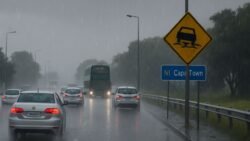Traffic Camera Rules – Traffic rules across South Africa are being updated this September 2025, with a particular focus on traffic camera regulations that will directly impact how millions of drivers navigate their daily commutes. The revised rules aim to reduce reckless driving, curb speeding, and ensure stricter adherence to road safety standards. Authorities have confirmed that the changes involve an expansion of camera-monitored zones, stricter fines for violations, and increased monitoring of busy intersections where congestion and accidents are common. For drivers, this means staying more alert than ever, as even small infractions such as rolling through stop signs or exceeding limits by a few kilometers per hour may trigger penalties. Commuters using highways and city routes should expect a noticeable difference in how traffic cameras operate, with real-time digital tracking now being used to link violations directly to vehicle registration systems. These changes could alter driving habits, potentially making routes slower but ultimately safer and more efficient for all road users.
New Camera Coverage Across Urban and Rural Areas
The September 2025 updates include a wide expansion of camera coverage, stretching beyond major highways into smaller towns and rural roads where violations often go unnoticed. This move is designed to ensure that road safety standards apply uniformly, whether you are traveling in a busy metropolitan hub or a quiet rural settlement. Drivers who previously bypassed camera-monitored highways by taking alternate back routes may now find these areas equally under surveillance. In addition, new mobile camera units will be introduced to cover accident-prone stretches on provincial roads, ensuring that offenders cannot predict where monitoring will occur. The government’s transportation department emphasizes that these upgrades are not solely about collecting fines but about fostering long-term discipline and accountability. For daily commuters, the implication is clear: routes that once seemed free of oversight are now just as closely watched, making compliance with speed and traffic laws the only safe option.
Stricter Fines and Real-Time Digital Enforcement
One of the most significant changes in the updated rules is the introduction of higher penalties and faster enforcement systems. Traffic cameras are now directly linked to centralized digital platforms that automatically issue fines and notifications to vehicle owners within hours of the violation being recorded. This reduces delays that previously allowed offenders to escape consequences or dispute charges without sufficient evidence. The fines themselves have also increased, with speeding, ignoring red lights, and improper lane usage now carrying steeper penalties. For repeat offenders, stricter action such as license suspensions or mandatory driving courses is being considered. This shift reflects the government’s commitment to road safety by making violations both costly and inconvenient. For regular drivers, the message is simple: habitual infractions that may have been overlooked in the past will now come with immediate financial consequences, making it more important than ever to drive responsibly.
Impact on Daily Commutes and Travel Time
For many South Africans, the new rules may initially feel like an added burden, particularly for those who travel long distances to work or school each day. Increased monitoring can mean more stops, stricter lane adherence, and slower speeds, all of which could lengthen commute times. However, authorities argue that the long-term benefits outweigh the short-term inconvenience. With fewer accidents, smoother traffic flow, and safer pedestrian crossings, the daily commute is expected to become more predictable and less stressful. Employers and employees alike may need to adjust schedules slightly to account for these changes, particularly in urban areas where congestion is already an issue. Public transportation systems may also see increased usage as some drivers prefer to avoid the hassle of stricter enforcement. Ultimately, the rules are designed not to hinder movement but to create safer, more reliable travel conditions for all.
How Drivers Can Prepare and Stay Compliant
Adapting to these changes will require drivers to pay closer attention to both posted signs and general driving etiquette. Staying within speed limits, making complete stops, and using designated lanes will be crucial to avoiding penalties. Navigation apps are expected to update their systems with alerts for camera-monitored zones, helping drivers adjust routes in advance. Vehicle owners should also ensure that their car registrations and driver details are up-to-date, as automated fines will be delivered electronically to registered contacts. Awareness campaigns are being launched to educate the public on the specifics of the new rules, emphasizing the importance of compliance for everyone’s safety. Drivers are encouraged to treat these updates not as punitive measures but as necessary steps toward safer roads. By adopting a more cautious approach and staying informed, commuters can continue their daily routes with confidence and contribute to reducing road accidents across the country.






